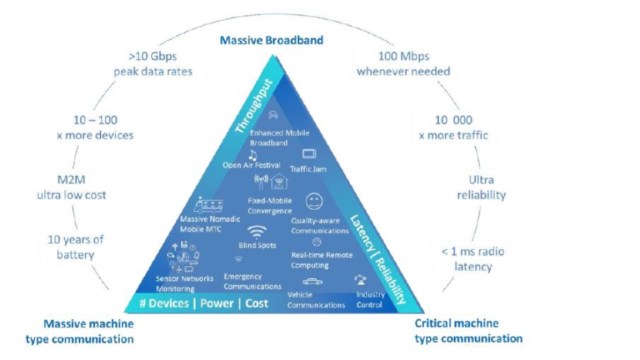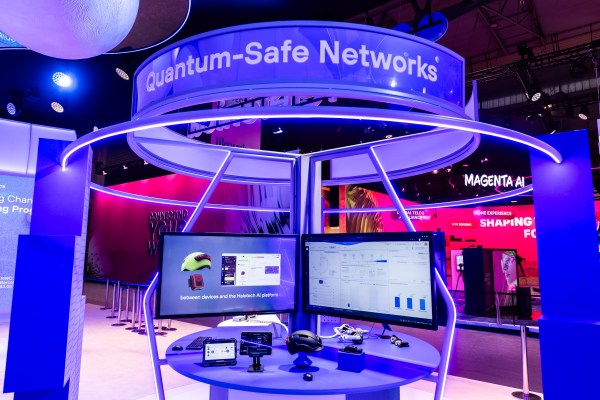Gartner then states that, ‘To successfully meet the growing demand for public cloud-based digital business initiatives, infrastructure and operations leaders must fundamentally restructure the “WAN”. Those who do not risk a costly and substandard user experience for internal and external customers.’ It is also estimated that the growth of data traffic over the ‘WAN’ will
Gartner then states that, ‘To successfully meet the growing demand for public cloud-based digital business initiatives, infrastructure and operations leaders must fundamentally restructure the “WAN”. Those who do not risk a costly and substandard user experience for internal and external customers.’ It is also estimated that the growth of data traffic over the ‘WAN’ will
According to a Gartner report on the evolution of mobile traffic access from LTE to 5G, global mobile Internet traffic is projected to increase significantly in the coming years. The firm estimates that aggregate mobile Internet traffic will grow by 45% per year to over 1,000 exabytes per year by 2027.
This growth will be driven mainly by the expansion of 5G coverage, the improvement in the speed of mobile networks, and the increased use of applications and services that require higher bandwidth, such as high-definition video transmission, augmented reality (AR), and virtual reality (VR).
This projection reflects the important role that 5G will play in the transformation of the telecommunications ecosystem, enabling greater data capacity, faster connectivity and reduced latency, which will boost mobile data consumption on an unprecedented scale.
This review is based on the report delivered by the International Telecommunication Union ‘ITU-R M.2243’, which assesses the current outlook and future mobile broadband needs that will be supported by the current state of the art, defined by the international mobile telecommunications standard or ‘IMT’ until 2020. The scenarios proposed by ‘IMT-2020’ in recommendation ‘ITU-R M.2083-0’ [4] added to the scenarios proposed by the collaboration of European organisational members ‘3GPP’ and ‘5GPPP’, who deliver their projection for mobile services [12] associated with emerging technologies. Some examples can be found in figures [1.1] and [1.2], associated with the three main scenarios, such as mobile broadband access or ‘eMBB’ (enhanced Mobile Broadband), ‘mMTC’ (massive Machine Type Communications) connection and, finally, the axis of real-time applications ‘URLLC’ (Ultra-Reliable and Low Latency Communications) [7.IV], for a mobile travelling at up to 500 km/h. BH&FH [9.XII, 14.I] will have to adapt its operation together with access [5, 7.V, 12], served by eNb, and the different NRs that will allow for the coordinated delivery [7.VI] of a better user experience, as detailed in the report ITU-R M.2320-0 (11/2014), which the technological trends of terrestrial IMT systems are presented that are applicable to radio interfaces, mobile terminals and transmission networks, considering the time frame 2015-2020, specifying the needs to be met by the new technologies such as capacity, scalability, flexibility, resilience, low latency, reliability and availability required in the different scenarios proposed by the ITU-R M.2370-0 report 70-0′ as shown in figure [1.1]. In the presentation of the ‘IMT-2020’, it estimates a growth of 10 to 100 times the user traffic for the period from 2020 to 2030, thus defining the feasibility of expanding the traffic-related backbone capacity or ‘BW’ by 1000 times considering the estimated service density indicated in point 1.2

3 pillars for 5G services
The three axes [13] associated with the development of 5G technologies [6.I, 6.IV] are described below:
The broadband network that supports the data traffic generated and required by the terminals and the applications that run on them. In general, spectral efficiency is estimated to be three times higher than current high-capacity cases, with expectations of reaching 10Mbp/s/m², which is why it is established that the maximum transfer speed could reach 10 Gbps in some scenarios, such as 3D telepresence on mobile devices. Accesses range from 1Gbps, so capacities of 10 Tb/s/km² are defined to cover, for example, a stadium with 30,000 devices, which transmit the event on social networks at 50 Mbps per EU. In general, a spectral efficiency three times better is expected.
Ultra-low latency communications with a traffic profile associated with applications that require real-time responses, with end-to-end (E2E) latencies of around 5 ms, to meet the high requirements for up-to-date data for automated transport vehicles. The 5G infrastructure of the future is expected to cope with 30-50 Mbps per UE.
The massive deployment of sensors and actuators typical of the Internet of Things (IoT), the massive loading of low-capacity services, it is estimated that around 1 million ‘UE’s’ must be served per square kilometre.
Analysis of the type of demand
The three main 5G service scenarios [6.IV, 9.VII] are analysed, associated with eMBB, mMTC and URLLC accesses as presented in table [2.1] and due to the nature of the traffic profile, each traffic flow must be treated separately. This results in different requirements such as bandwidth capacity or ‘BW’, massiveness in terms of the number of elements to be served, availability and performance for BH&FH.
Table 2.1 Minimum technical requirements for performance, reference ‘ITU-R Workshop on IMT-2020 terrestrial radio interfaces, Nokia’ [6.IV]
Bibliographic References
[1] «Reporte Gatner asociado a negocios digitales y las nuevas arquitecturas de redes WAN, basado en atención de más 2000 clientes, Mark Fabbi, Neil Rickard». [ID G00317251]. https://www.gartner.com/en. [11 de 2016].
[2] «Common Public Radio Interface, eCPRI presentacion, 2018 Ericsson AB, HuaweiTechnologies Co. Ltd Corporation and Nokia». Disponible. http://www.cpri.info. [01 2018]
[2.I] «eCPRI Transport Network V1.0, Requirements Specification Common Public Radio Interface: Requirements for the eCPRI Transport Network». [01 2018].
[2.II] «eCPRI Specification V1.1, Interface Specification Common Public Radio Interface: eCPRI Interface Specification». [01 2018].
[3] «Research Trends and IMT Beyond 2020. [Online]». J. Skold. Disponible: https://www.itu.int/en/ITU-D/Regional-Presence/AsiaPaci_c/Documents/. [02 2014].
[4] «Visión IMT 2020 basada en la recomendación ITU-R M.2083-0, Capítulos 4-5». Disponible: https://www.itu.int/dms_pubrec/itu-r/rec/m/R-REC-M.2083-0-201509-I!!PDF-E.pdf. [10/2015].
[5] MONA JABER1 (miembro estudiante, IEEE), MUHAMMAD ALI IMRAN1 (miembro sénior, IEEE), «5G Backhaul Challenges and Emerging Research Directions: A Survey». ID 10.1109 / ACCESS.2016.2556011, https://ieeexplore.ieee.org/Xplore/. [5/2016].
[6] «Workshop on IMT-2020 terrestrial radio interfaces, Presentations by registered independent evaluation groups, 5G Infrastructure Association (5GPPP-EU)». Disponible: https://www.itu.int/en/ITU-R/study-groups/rsg5/rwp5d/imt-2020/Pages/ws-20171004.aspx, [10 2017].
[6.I] «Presentaciones de posibles proponentes de IMT-2020 RIT/SRIT», «Parámetros de rendimiento de servicios 5G según ETSI DECT», Sr. Daniel Hartnett (Foro DECT). [10 2017].
[6.II] «Presentaciones de grupos de evaluación independientes registrados, Asociación de Infraestructura 5G (5GPPP-EU)», Sr. Werner Mohr (Nokia Solutions and Networks). [10 2017].
[6.III] «Mapa de avance de versión 15 a la 16 3GPP 5G», Sr. Giovanni Romano (Telecom Italia, 3GPP). [10 2017].
[6.IV] «Minimum Technical Performance Requeriments for IMT-2020 RIT, Eiman Mohyeldin, NEC». [10 2017].
[6.V] «Directrices para la evaluación de las tecnologías de interfaz de radio para IMT-2020. Informe UIT-R M.[IMT-2020.EVAL]», Dr. Ying Peng (DaTang Telecommunication Technology & Industry Holding Co. Ltd, República Popular China), Dr. Jungsoo Jung (Samsung, República de Corea Copresidentes del SWG EVALUATION en el UIT-R WP5D)
[6.VI] «Aspectos arquitectónicos del acceso radioeléctrico de onda milimétrica, 5G PPP mmMAGIC, integración con el ecosistema 5G». [04 2016].
[7] «Proyecto de Asociación de Tercera Generación». Disponible: http://www.3gpp.org/about-3gpp. [12 2018].
[7.1] «Descripción de interfaz S1, EUTRAN REL 15, 3GPP TS 36.414 V15.0.0». [2018-06].
[7.II] «Descripción de interfaz X2, EUTRAN REL 15, 3GPP TS 36.424 V15.0.0». [2017-12].
[7.III] «Descripción de interfaz EUTRAN arquitectura REL 15, capítulo 6, 3GPP TS 36.401 V15.0.0». [2017-12]
[7.IV] «Proyección de servicios 3GPP 5G, versión 16, para UIT – R IMT – proyección al 2020». Keith Mallinson. Disponible en http://www.3gpp.org/news-events/3gpp-news/1774-5g_wiseharbour. [05 2016]
[7.V] «Aspectos de sistemas y especificaciones técnicas sobre interfaces y arquitecturas para tecnologías 5G, 3rd Generation Partnership Project». 3GPP TS 23.501 V15.2.0». Capítulo 4 – 5. [06 2018].
[7.VI] «Aspectos de sistemas y especificaciones técnicas sobre Conceptos MANO, «Gestión y orquestación de redes 5G». 3GPP TS 28.530 V1.2.2» (Versión 15), capítulo 4-5. [08 2018].
[7.VII] «Estudio sobre escenarios y requisitos para tecnologías de acceso de próxima generación». 3GPP TR 38.913 versión 14.2.0 (Release 14). [2017-05].
[7.VIII] «Descripción del estado de las NR y NG_RAN, REL 15». 3GPP TS 38.300 V15.2.0. [06 2018].
[7.IX] «Aspectos de sistemas y especificaciones técnicas sobre tecnologías 5G», «Estudio sobre aspectos funcionales y de sistemas de la eficiencia energética en redes 5G (versión 16)». 3GPP TR 32.972 V0.5.0, capítulos 4.2.3 – 10. [09 2018].
[7.X] «Aspectos de sistemas y especificaciones técnicas sobre provisión, gestión y orquestación de redes 5G» 3GPP TS 28.531 V1.2.2 (2018-08), capítulos 4-5. [08 2018].
[7.XI] «Presentación roadmap servicios 3GPP de relase 15 a 16, Balazs Bertenyi, Chairman of 3GPP RAN». [email protected]. Disponible; http://www.3gpp.org/ftp/Information/presentations/presentations_2018/RAN80_webinar_summary(brighttalk)extended.pdf. [06 2018]
[7.XII] «5G; Requisitos de servicio para nuevos servicios y mercados de próxima generación». 3GPP TS 22.261 versión 15.5.0 Release 15, Capítulo 6. [07 2018].
[7.XIII] «Especificación técnica del grupo de servicios y aspectos del sistema; gestión de las telecomunicaciones; principios y requisitos de alto nivel (versión 15)». 3GPP TS 32.101 V15.0.0, capítulos 6-7. [09 2017]
[7.XIV] «Especificación técnica del Grupo de Servicios y Aspectos del Sistema; Política y arquitectura de control de cobro (Versión 15), Política y arquitectura de control de cobro». 3GPP TS 23.203 V15.3.0, [06 2018]
[8] «Este documento ha sido elaborado y aprobado por el Grupo de Especificaciones Industriales (ISG) de ETSI sobre Virtualización de Funciones de Red (NFV) y representa las opiniones de los miembros que participaron en este ISG. No representa necesariamente las opiniones de todos los miembros de ETSI». Virtualización de Funciones de Red (NFV); Terminología para los Principales Conceptos en NFV. ETSI GS NFV 003 V1.3.1. [01 2018].
[8.I] Arquitectura de la virtualización de funciones de red (NFV). ETSI GS NFV 002 V1.2.1. [12 2014].
[8.II] Informe sobre el uso de SDN en el marco arquitectónico de la NFV. ETSI GS NFV-EVE 005 V1.1.1. [12 2015].
[8.III] «Network Functions Virtualisation (NFV) Release 3; Management and Orchestration; Report on Management and Connectivity for Multi-Site Services». ETSI GR NFV-IFA 022 V3.1.1. [04 2018].
[8.IV] «Virtualización de funciones de red (NFV); Descripción general de la infraestructura». ETSI GS NFV INF 001 V1.1.1. [01 2015].
[8.V] «Virtualización de funciones de red (NFV); Gestión y orquestación; Exención de responsabilidad de la especificación de requisitos funcionales». ETSI GS NFV-IFA 010 V2.1.1. [04 2016].
[8.VI] «Virtualización de funciones de red (NFV), gestión y orquestación de la arquitectura de funciones de red virtual». ETSI GS NFV-MAN 001 V1.1.1. [12 2014]
[8.VII] «Virtualización de funciones de red (NFV)». ETSI GS NFV-SWA 001 V1.1.1. [12 2014]
[8.VIII] «Gestión y orquestación, especificación de empaquetado de VNF, virtualización de funciones de red (NFV), gestión y orquestación». ETSI GS NFV-IFA 011 V2.4.1. [2018-02].
[8.IX] «5G; System Architecture for the 5G System (3GPP TS 23.501 versión 15.2.0 Release 15)». ETSI TS 123 501 V15.2.0. [06 2018].
[8.X] «Perspectivas para la operación de red basadas en la virtualización (NFV), basadas en las prioridades, capítulos 2-3. 5G. http://portal.etsi.org/NFV/NFV_White_Paper_5G.pdf. [02 2017].
[8.XI] «OSM RELEASE THREE A TECHNICAL OVERVIEW MANO, An ETSI OSM Community White Paper». [10 2017].
[8.XII] «Network Functions Virtualisation (NFV); Acceleration Technologies;VNF Interfaces Specification». ETSI GS NFV-IFA 002 V2.1.1, Capitulos 5.11 VXLAN offloading functional group. [2016-03].
[8.XIII] ´Network Functions Virtualisation (NFV); Infrastructure; Hypervisor Domai´. ETSI GS NFV-EVE 004 V1.1.1. [03 2016].
[8.XIV] «Virtualización de funciones de red (NFV); Tecnologías de aceleración; Especificación de aspectos de gestión». ETSI GS NFV-IFA 004 V2.1.1. [04 2016].
[8.XV] «Virtualización de funciones de red (NFV) Versión 2; Tecnologías de aceleración; Especificación de aceleración y evaluación comparativa de vSwitch». ETSI GS NFV-IFA 003 V2.4.1. [02 2018].
[8.XVI] «Metodología para describir interfaces y abstracciones de infraestructura, virtualización de funciones de red (NFV)». ETSI GS NFV-INF 007 V1.1.1. [10 2014].
[9] Las Comisiones de Estudio del Sector de Normalización de las Telecomunicaciones de la UIT (UIT-T) reúnen a expertos de todo el mundo para elaborar normas internacionales conocidas como Recomendaciones UIT, que actúan como elementos definitorios de la infraestructura mundial de las Tecnologías de la Información y la Comunicación (TIC). https://www.itu.int/es/ITU-T/about/Pages/default.aspx.
[9.I] ´Interfaces for the optical transport network, Corrigendum 1. ITU-T G.709/Y.1331. [08 2017].
[9.II] ´Next Generation Networks – Frameworks and functional architecture models General overview of IPv6-based NGN, SERIES Y’. ITU-T Y.2051. [02 2018].
[9.III] «Funciones y mecanismos de operación, administración y mantenimiento (OAM) para redes basadas en Ethernet». UTI – T G.8013/Y.1731. [08 2015].
[9.IV] «Características de los bloques funcionales de los equipos de la red de transporte Ethernet», SERIE G y SERIE Y». UIT-T G.8021/Y.1341. [06 2018].
[9.V.a] «Transmission media and optical systems characteristics – Characteristics of optical systems Spectral grids for WDM applications: DWDM frequency grid». UIT-T G.694.1. [02 2012]
[9.V.b] «Características de los medios de transmisión. Características de los componentes y los subsistemas ópticos». UIT-T G.694.2. [12 2003]
[9.VI] «SERIE G: Paquetes sobre aspectos de transporte: objetivos de sincronización, calidad y disponibilidad» y «SERIE Y: Aspectos del protocolo de Internet: transporte». UIT-T G.8271/Y.1366. [08 2017]
[9.VII] «Directrices de recomendación para la evaluación de tecnologías de interfaz de radio para IMT-Avanzado». UIT-R M.2135-1. [12/2009]
[9.VIII] «PROYECTO DE NUEVO INFORME UIT-R M.[IMT-2020.EVAL], Directrices para la evaluación de tecnologías de interfaz radioeléctrica para IMT-2020». Capítulo 8. [10 2017]
[9.IX] «Perfil de telecomunicaciones del protocolo de tiempo de precisión para la sincronización de fase/tiempo con sincronización completa, soporte de la red Paquete sobre aspectos de transporte: objetivos de sincronización, calidad y disponibilidad». UIT-T G.8275.1/Y.1369.1. [07/2014]
[9.X] «Datos sobre transporte: aspectos genéricos: aspectos de control de la red de transporte». UIT-T G.7714.1/Y.1705.1. [08/2017]
[9.XI] «Arquitectura funcional genérica de las redes de transporte». Recomendación UIT-T G.805. [03 2000].
[9.XII] «Recomendaciones en la arquitectura y topología de red de transporte según». REPORTE ITU-R M.2375-0. capítulo 7-10. [06 2015].
[9.XIII] «Plan de trabajo de normalización de redes y tecnologías de transporte óptico. Tema: Redes y tecnologías de transporte óptico y de otro tipo (OTNT), estado de IEEE 802.1. Tramas Ethernet sobre transporte FlexE en OIF». [02 2017]. https://www.itu.int/en/ITU-T/studygroups/com15/Pages/otn.aspx
[9.XIV] «Arquitectura funcional de las redes de capa sin conexión», SERIE G: SISTEMAS Y MEDIOS DE TRANSMISIÓN, SISTEMAS Y REDES DIGITALES». UIT-T G.809. [03 2003].
[9.XV] «Recomendaciones Servicios & OAM». Actualización de UIT-T SG13 y SG15 Dinesh Mohan (Nortel) – Enlace SG13 // Hiroshi Ohta (NTT) – Enlace SG15. Disponible; http://www.ieee802.org/1/files/public/docs2006/ag-mohand-liaison-itut-sg13-15-update.pdf
[9.XVI] ´SERIE X: REDES DE DATOS Y COMUNICACIÓN ENTRE SISTEMAS ABIERTOS, SECCIÓN 3 – DEFINICIÓN DEL SERVICIO EN MODO SIN CONEXIÓN´. UIT-T X.213 | ISO/IEC 8348. [10 2001].
[9.XVII] «REDES DE DATOS Y COMUNICACIÓN ENTRE SISTEMAS ABIERTOS. INTERCONEXIÓN DE SISTEMAS ABIERTOS – DEFINICIONES DE LOS SERVICIOS, SECCIÓN 3 – DEFINICIÓN DEL SERVICIO EN MODO SIN CONEXIÓN. UIT-T X.214». [11 1995].
[9.XVIII] Interconexión de sistemas abiertos – Definición del servicio de enlace de datos, recomendación UIT-T X.212 [11 1995]
[9.XIX] Interconexión de sistemas abiertos (ISA); seguridad, estructura y aplicaciones del CCITT, recomendación X.800. CCITT X.800. [03 1991].
[9.XX] «Interconexión de sistemas abiertos – Modelo y notación tecnológica de la información – Modelo de referencia básico, recomendación UIT-T X.200 – ISO/CEI 7498-1 : 1994 (S) ». [11 1995]
[9.XXI] «Definición del servicio físico». Recomendación UIT-T X.211. [11 1995]
[9.XXII] «Protocolo para proporcionar el servicio de red sin conexión: Especificación del protocolo». X.233. [08 1997].
[9.XXIII] «Aspectos del protocolo de Internet: características del servicio de transporte Ethernet». UIT-T G.8011/Y.1307. [11 2016].
[9.XXIV] «Calidad de servicio: guía para métodos y mecanismos». UIT-T X.642. [09 1998]
[9.XXV] «Next Generation Networks – Quality of Service and performance Ethernet QoS control for next generation networks». Recomendación UIT-T Y.2113. [01 2009]
[9.XXVI.a] «ITU-T Rec. G.8261 que define aspectos sobre la arquitectura y el rendimiento de la itinerancia de las redes SyncE»
[9.XXVI.b] Recomendación UIT-T G.8262 que especifica los relojes Ethernet síncronos para SyncE.
[9.XXVI.c] Recomendación UIT-T G.8264 que describe la especificación del canal de mensajes de sincronización Ethernet (ESMC).
[9.XXVII] «Redes de próxima generación: calidad de servicio y rendimiento. Control de calidad de servicio de Ethernet para redes de próxima generación». Recomendación ITU-T Y.2113. [01 2009]
[9.XXVIII] «Sistemas de procesamiento de la información. Interconexión de sistemas abiertos. Organización interna de la capa de red, ISO 8648 primera edición» [02 1988].
[10] ´IEEE GET Program TM, GET 802(R) Standards´. Disponible; https://ieeexplore.ieee.org/browse/standards/get-program/page/
[10.I] «Especificaciones de 802-2014 – IEEE Standard for Local and Metropolitan Area Networks: Overview and Architecture, Revision of IEEE Std 802-2001». Revisión de IEEE Std 802-1990.
[10.II] «802c-2017 – IEEE Standard for Local and Metropolitan Area Networks: Descripción general y arquitectura. Enmienda 2: Uso de direcciones de control de acceso al medio (MAC) local, IEEE Std 802-2014. Revisión IEEE Std 802-2001.
[10.III] Puente de ruta de prueba IEEE 802.1aq, IEEE Interim San Diego. [07 2010]
[10.IV] «IEEE TSN». Disponible; https://1.ieee802.org/tag/tsn/
[10.IV.a] «Recomendaciones 802.1AV Time Synchronization for Wired and Wireless 802 LANs». Kevin Stanton, Intel Corporation. [5 2006].
[10.IV.b] «TSN, Timestamp-Based Synchronization Contribution for IEEE». Autor: Serge F. Fourcand / Huawei Technologies (EE. UU.). [10 2008]
[10.V] «Norma IEEE para Ethernet, SECCIÓN SEIS, Norma IEEE 802.3-2015». Capítulo 80, Introducción a las interfaces de red de 40 Gb/s y 100 Gb/s.
[10.VI] «802.1 – Activities & status», Glenn Parsons, presidente, IEEE 802.1 WG, [email protected] // John Messenger, vicepresidente, IEEE 802.1 WG, [email protected]. [07 2018]. Disponible; https://mentor.ieee.org/802-ec/dcn/18/ec-18-0112-00-00EC-802-1-opening-report.pdf
[10.VII] «802.1CF Network Reference Model and Functional Description of IEEE 802 Access Network». Disponible en https://1.ieee802.org/omniran/802-1cf/.
[10.VII.a] «IEEE P802.1CF para aplicaciones verticales, IEEE 802.1 OmniRAN T. Presidente: Max Riegel. Modelo de referencia de red 802, alcance backhaul medio, descripción funcional y virtualización de red. (Nokia Bell Labs). Omniran-18-0027-00-00TG, ec-16-0039-01-5GSG, Omniran-14-0037-00-00TG.
[10.VIII.a] ´P802.1DC – Quality of Service Provision by Network Systems´. [05 2018]
[10.IX] «Norma para redes de área local y metropolitana: puentes de control de acceso al medio (MAC) y redes de área local con puente virtual. Enmienda: mejoras del protocolo de reserva de flujo (SRP) y mejoras del rendimiento. PAR para la prestación de calidad de servicio para no puentes, PAR 802.1XY. Norman Finn Huawei Technologies Co. Ltd v03. [03 2018]
[10.X] «Especificación base del protocolo de intercambio de capacidad DCB, protocolo base DCBX Rev. 1.01». Manoj Wadekar (Qlogic). [11 2009].
[10.XI] «Agrupación por prioridades para redes DCB Selección de transmisión mejorada (ETS), Rev. 1.01». IEEE – 802.1Qaz. Manoj Wadekar (Qlogic). [11 2009].
[10.XII.a] «802.1Qay, Carrier Bridge Architecture, Joint ITU-T/IEEE Workshop on Carrier-class Ethernet, Ginebra». Stephen Haddock // Director de Tecnología // Extreme Networks. [06 2007].
[10.X.II.b] «802.1Qay. Red PBB/PBB-TE con servicio B, 802.1aq / capas B-VLAN y 802.1Qay / B-Tunnel». Maarten Vissers. [11 2007]
[10.XIII] «802.1AC™-2016, (Revisión de IEEE Std 802.1AC-2012), Definición de servicio de control de acceso al medio (MAC)». Nueva York, NY 10016-5997. [2016]
[11] «Open Network Foundationm, 2275 E. Bayshore Road, Suite 103, Palo Alto, CA 94303». https://www.opennetworking.org/sdn-definition/
[11.I] ONF SDN Evolution» Versión 1.0 ONF TR-535 08-09-2016
[11.II] «Requisitos funcionales para la API de transporte. ONF TR-527. [06 2016]
[11.III] «Modelo de información de microondas versión 1.0». TR-53. [12 2016]
[11.IV] ´OpenFlow Management and Configuración OF-CONFIG 1.2 Protocol ONF TS-016 Copyright©. [2014]
[12] Estudio sobre la infraestructura pública, privada y las próximas redes y servicios asociados, Proyecto Comisión Europea Horizon 2020, Visión 5GPPP, contrato 643973, capítulos 3-4, https://5g-ppp.eu/roadmaps/, [02 2015]
[12.I] «5G – Xhaul – Backhaul/Fronthaul óptico-inalámbrico reconfigurable dinámicamente con plano de control cognitivo para celdas pequeñas y RAN en la nube D2.1», D2.1 Especificación de requisitos y documento de KPI, Capítulos 4-5. [06 2015]
[12.II] ´ Service Function Chaining (SFC) and Network Slicing in Backhaul and Metro Networks in Support of 5G, Commission for the H2020-ICT-2016-2 METRO-HAUL project. G.A. 761727. Adrian Farrel : Old Dog Consulting.[2018]
[13] «Mejoras para una arquitectura de red multiservicio adaptativa 5G». Disponible: https://5gnorma.5g-ppp.eu/, 5G NORMA, 5GPPP: https://5g-ppp.eu/. [04 2017].














